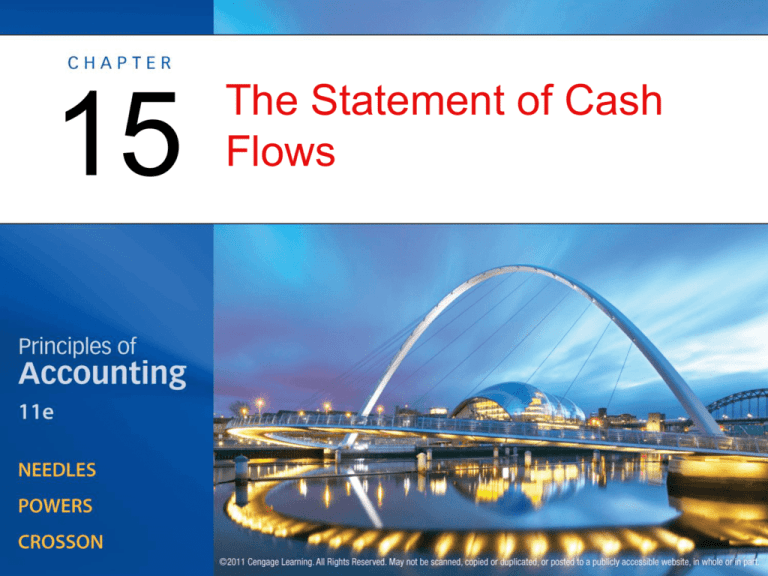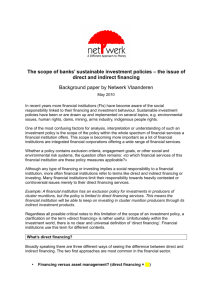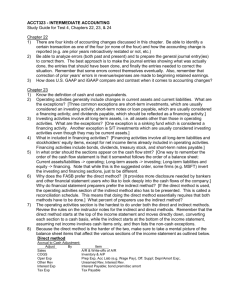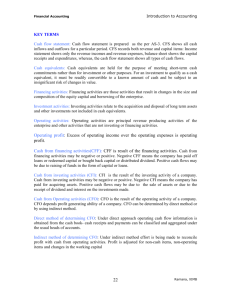
15
The Statement of Cash
Flows
Overview of the Statement of Cash Flows
OBJECTIVE 1: Describe the principal
purposes and uses of the statement of cash
flows, and identify its components.
Figure 1: Classification of Cash Inflows
and Cash Outflows
Exhibit 1: Consolidated Statement of Cash
Flows
Exhibit 1: Consolidated Statement of Cash
Flows
Exhibit 1: Consolidated Statement of Cash
Flows
Overview of the Statement of Cash Flows
• The statement of cash flows is a major
financial statement.
Overview of the Statement of Cash Flows
• Purposes of the statement of cash flows
– The statement of cash flows provides
information that is not provided by the other
three statements.
Overview of the Statement of Cash Flows
• Purposes of the statement of cash flows
(cont.)
– The statement of cash flows shows the effects
on cash and cash equivalents of operating,
investing, and financing activities.
• Cash equivalents are short-term, highly liquid
investments.
• Marketable securities are not cash equivalents.
– The statement of cash flows provides
information about a company’s cash receipts
and cash payments.
Overview of the Statement of Cash Flows
• Uses of the statement of cash flows
– The statement of cash flows also provides
information about a company’s investing and
financing activities.
Overview of the Statement of Cash Flows
• Uses of the statement of cash flows (cont.)
– Investors, creditors, and management use the
statement of cash flows for many reasons:
• To assess a company’s ability to generate positive
future cash flows
• To assess a company’s ability to pay debts
• To assess a company’s ability to pay dividends
• To assess a company’s need for additional financing
• To plan for investing idle cash
Overview of the Statement of Cash Flows
• Classification of cash flows
– Operating activities include cash received from
customers; interest and dividends received;
sales of trading securities; and cash paid for
wages, goods, services, interest, taxes, and
purchases of trading securities.
Overview of the Statement of Cash Flows
• Classification of cash flows (cont.)
– Investing activities involve long-term asset and
marketable-security transactions and loans
made and collected.
– Financing activities involve stock, bond, and
note transactions, as well as dividends paid.
• A schedule of noncash investing and
financing transactions should accompany
the statement of cash flows.
Overview of the Statement of Cash Flows
• In the statement of cash flows, individual
cash inflows and outflows are shown
separately in their respective categories.
Overview of the Statement of Cash Flows
• Unethical means of falsely enhancing cash
flows range from failing to fully disclose
financial transactions to misclassifying
payments and expenses.
©2011 Cengage Learning All Rights Reserved. May not be scanned, copied or duplicated, or posted to a publicly accessible website, in whole or in part.
Analyzing Cash Flows
OBJECTIVE 2: Analyze the statement of
cash flows.
Analyzing Cash Flows
• Many companies put their cash to good use,
but sometimes shareholders suffer when
management is too conservative and keeps
cash in low-yielding assets.
Analyzing Cash Flows
• Cash-generating efficiency is the ability of
a company to generate cash from
operations.
– Cash flow yield is the quotient of net cash
flows from operating activities divided by net
income.
– Cash flows to sales is the quotient of net cash
flows from operating activities divided by net
sales.
Analyzing Cash Flows
• Cash-generating efficiency is the ability of
a company to generate cash from
operations. (cont.)
– Cash flows to assets is the quotient of net cash
flows from operating activities divided by
average total assets.
Analyzing Cash Flows
• To interpret a statement of cash flows, it is
important to know the right questions to
ask.
– Why did cash flow from operating activities
differ from net income?
– What investing activities are important other
than capital expenditures?
– How did the company manage it’s financing
activities during the fiscal year?
Analyzing Cash Flows
• Free cash flow is net cash flows from
operating activities less dividends and
investments in plant assets plus proceeds
from the sale of plant assets.
©2011 Cengage Learning All Rights Reserved. May not be scanned, copied or duplicated, or posted to a publicly accessible website, in whole or in part.
Operating Activities
OBJECTIVE 3: Use the indirect method to
determine cash flows from operating
activities.
Exhibit 2: Income Statement
Exhibit 3: Comparative Balance Sheets
Showing Changes in Accounts
Exhibit 3: Comparative Balance Sheets
Showing Changes in Accounts
Exhibit 3: Comparative Balance Sheets
Showing Changes in Accounts
Figure 2: Indirect Method of Determining
Net Cash Flows from Operating Activities
Exhibit 4: Schedule of Cash Flows from
Operating Activities: Indirect Method
Operating Activities
• Under the indirect method, cash flows from
operating activities equal net income
adjusted by items that increase or decrease
cash flow from operations.
– Items to be added back to net income:
• Depreciation expense, amortization expense, and
depletion expense
• Losses
Operating Activities
• Under the indirect method, cash flows from
operating activities equal net income
adjusted by items that increase or decrease
cash flow from operations. (cont.)
– Items to be added back to net income:
• Decreases in accounts receivable, inventory, and
prepaid expenses
• Increases in accounts payable, accrued liabilities,
and income taxes payable
Operating Activities
• Under the indirect method, cash flows from
operating activities equal net income
adjusted by items that increase or decrease
cash flow from operations. (cont.)
– Items to be deducted from net income:
• Gains
• Increases in accounts receivable, inventory, and
prepaid expenses
• Decreases in accounts payable, accrued liabilities,
and income taxes payable
Operating Activities
• The direct and indirect methods produce
the same results, and both are GAAP.
©2011 Cengage Learning All Rights Reserved. May not be scanned, copied or duplicated, or posted to a publicly accessible website, in whole or in part.
Investing Activities
OBJECTIVE 4: Determine cash flows from
investing activities.
Investing Activities
• Investing activities include the following:
– Purchase and sale of long-term assets
– Purchase and sale of short-term investments
Investing Activities
• Gains and losses under the indirect
approach.
– deducted from and added back to net income to
arrive at net cash flows from operating
activities
– full cash proceeds are entered into the cash
flows from investing activities section of the
statement of cash flows
• Upon a sale, the full cash proceeds are
entered into the statement of cash flows.
Investing Activities
• Upon a purchase, the full cash outflows are
entered into the statement of cash flows.
©2011 Cengage Learning All Rights Reserved. May not be scanned, copied or duplicated, or posted to a publicly accessible website, in whole or in part.
Financing Activities
OBJECTIVE 5: Determine cash flows from
financing activities.
Exhibit 5: Statement of Cash Flows:
Indirect Method
Exhibit 5: Statement of Cash Flows:
Indirect Method
Exhibit 5: Statement of Cash Flows:
Indirect Method
Financing Activities
• Financing activities include the following:
– Short- and long-term borrowing (notes and
bonds) and repayment
– Issuance and repurchase of capital stock
• Changes in retained earnings are explained
through analyses of net income and
dividends declared.
Financing Activities
• The direct and indirect methods differ only
in the cash flows from operating activities
section of the statement of cash flows.
• Exhibit 5 shows a completed indirect
method statement of cash flows.
– The essence of the indirect approach is the
conversion of net income to net cash flows
from operating activities.
©2011 Cengage Learning All Rights Reserved. May not be scanned, copied or duplicated, or posted to a publicly accessible website, in whole or in part.






